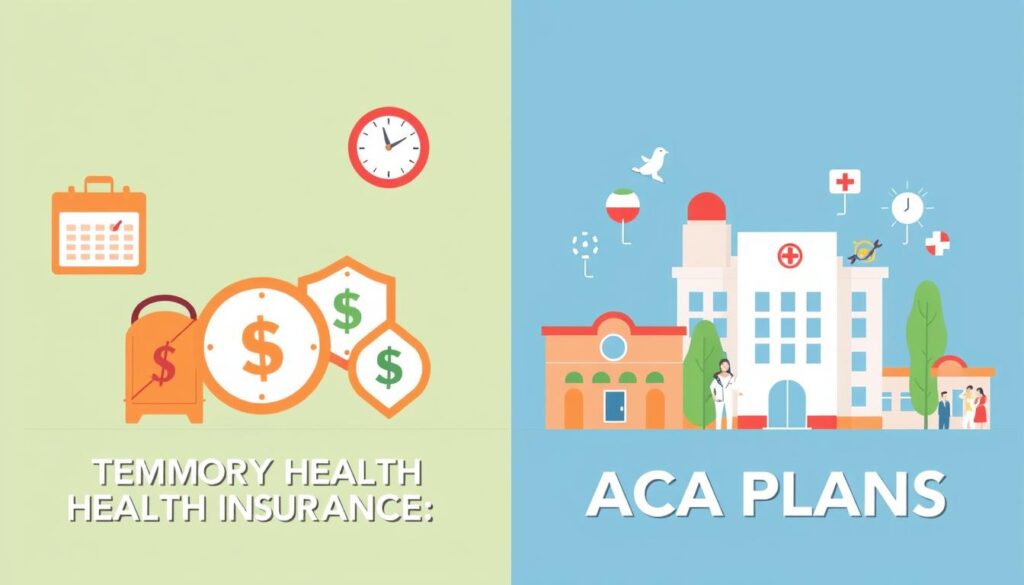
Life can change fast, and temporary health insurance helps a lot. It’s also called temporary medical insurance or short term health coverage. This insurance gives you medical protection when you need it most.
welcome to cegen.org
Temporary Health Insurance!
Maybe you’re switching jobs, moving, or waiting for ACA enrollment. Short term health coverage can make you feel safer. I’ll talk about when it’s good, what it covers, and how to pick the right one for you.
My aim is to make this topic easier to understand. I want to help you find the right coverage for uncertain times.
Key Takeaways
- Temporary health insurance serves as a crucial safety net during life transitions.
- This type of insurance is often more cost-effective than comprehensive plans.
- Coverage typically begins shortly after enrollment without needing to wait for open enrollment periods.
- Temporary health insurance may not cover pre-existing conditions or essential health benefits.
- Understanding the limitations of short term health coverage helps in making informed decisions.
- Finding the right provider is essential to ensure adequate medical protection.
What is Temporary Health Insurance?

Temporary health insurance is also known as short term health insurance. It’s for people in between health plans. These plans last a few months to a year.
They help during job changes or when waiting for new health insurance. But, these plans have some big limits.
These plans don’t cover pre-existing conditions. So, people might not get help for health issues they had before. Also, these plans don’t have to follow the Affordable Care Act (ACA).
This means they don’t offer the same benefits as regular plans. Some plans can be renewed for up to 36 months. But, starting September 1, 2024, they will only last four months.
Here’s a table that shows what temporary health insurance is all about:
| Aspect | Temporary Health Insurance | Traditional Health Insurance |
|---|---|---|
| Coverage Duration | Up to 4 months (maximum); possible extensions | Typically 12 months or longer |
| Coverage for Pre-existing Conditions | No | Yes |
| Compliance with ACA | No | Yes |
| Lifetime Maximum Benefits | $250,000 – $2 million | No maximum limit (out-of-pocket max applies) |
| Coverage of Essential Benefits | Limited | Comprehensive |
In short, temporary health insurance is good for short gaps. But, it has big limits and doesn’t cover everything. Think about your health needs before choosing.
When to Consider Temporary Health Insurance
Temporary health insurance is key during life changes. It’s great for many situations, like:
- Waiting for health benefits from a new employer to start
- Transitioning off a parent’s health plan after turning 26
- Missing the open enrollment period for an ACA plan
- Experiencing a job loss or change
- Needing a bridge in coverage while exploring longer-term options
Short duration health insurance is very useful. It lets me pick a plan that suits me without big commitments. Plus, many plans start right after I apply, giving me quick coverage.
Knowing when to choose short-term health insurance helps a lot. It has good points and bad, but it’s often the best choice when I need health coverage fast. I think about its limits, like no coverage for pre-existing conditions. But, its flexibility usually works for me.
Understanding Short Term Health Coverage
Short term health coverage is a flexible option for those needing temporary health insurance. These plans last less than a year but can be renewed for up to three years in some places. They are made for people under 65 who don’t need ongoing care for health issues.
These plans are quick and affordable. They might cost 20% less than the cheapest ACA plan. But, they have big limits. For example, 43% don’t cover mental health, 62% don’t cover substance abuse, and 71% don’t cover prescription drugs.
These plans don’t count as minimum essential coverage under the ACA. This can lead to tax penalties. A survey found 51% chose them for being cheaper, and 39% needed temporary coverage. It’s key to check what each plan covers, as many don’t include important services like maternity care.
| Coverage Type | Short Term Health Coverage | ACA-Compliant Plans |
|---|---|---|
| Duration | Less than 12 months | A full calendar year or longer |
| Cost | Up to 20% less than ACA plans | Subsidized options available |
| Maternity Care | No coverage available | Included |
| Pre-Existing Conditions | No coverage | Covered without underwriting |
| Enrollment Period | Anytime | Open Enrollment or Special Enrollment Periods |
In conclusion, short term health coverage is quick and cheap. But, it’s vital to look at each plan’s good and bad points. This ensures it fits your temporary health needs well.
Benefits of Temporary Health Insurance
Temporary health insurance has many good points. It gives quick coverage, often starting the next day. This is very helpful in urgent situations.
It’s also affordable. Prices start at under $100 a month. This is much cheaper than long-term plans, saving you money.
It’s flexible too. You can choose how long you want coverage, from 30 to 90 days. This is great for times like job changes or waiting for other plans.
It covers basic doctor visits and emergencies. This means you can get medical help when you need it. Even if it has some limits, like no coverage for past health issues.
In short, temporary health insurance is a good choice. It offers quick, affordable coverage without the hassle of long-term plans.
Drawbacks of Temporary Health Insurance

Temporary health insurance can be helpful for some. But, it’s important to know its downsides. High deductibles are a big issue. This means you might have to pay a lot for medical care.
Another big problem is that these plans don’t cover pre-existing conditions. If you have ongoing health issues, these plans might not be enough. Also, they often don’t cover important services like:
- Maternity care
- Prescription drugs
- Mental health benefits
- Substance use disorder services
These plans also have limits on how much they’ll pay for care. For example, hospital stays might only be covered up to $1,000 a day. ICU care could be capped at $1,250 daily. Some plans even have total benefit caps as low as $100,000.
There’s no promise that you can keep your temporary insurance. Insurers can deny claims or cancel coverage for pre-existing conditions. This leaves you without the care you need. In some places, rules might affect your options, but they’re not as good as regular plans.
While temporary insurance can be a quick fix, it’s not perfect. People with chronic conditions or those needing full benefits should think twice. These plans have big limitations.
How Temporary Health Insurance Differs from ACA Plans
It’s important to know the differences between temporary health insurance and ACA plans. Temporary health insurance is flexible but has limits. It’s a good choice for some, but not all.
Temporary health insurance can be cheaper. It might cost 50% less than ACA plans. For example, ACA plans in 2019 cost about $612 a month on average.
ACA plans must cover ten essential health benefits. Temporary plans often don’t cover as much. This means I need to think about what health services I need before choosing a temporary plan.
ACA plans are easy to get, no matter your health history. Temporary plans require a health check. Temporary plans are also available all year, unlike ACA plans.
The following table summarizes these differences:
| Feature | Temporary Health Insurance | ACA Plans |
|---|---|---|
| Cost of Premiums | Typically 50% lower | Average $612 (2019) |
| Coverage Start Date | As soon as the day after enrollment | Usually within 30-45 days |
| Coverage Requirements | Varies; may lack essential benefits | Covers 10 essential health benefits |
| Pre-existing Condition Coverage | Not covered | Covered |
| Application Process | Not guaranteed issue; medical evaluation required | Guaranteed issue; accepted automatically |
| Availability | Available year-round | Limited to open enrollment |
Knowing these differences helps me see when temporary health insurance is a good choice. It’s about finding the right fit for my health and money.
Coverage Options in Short Duration Health Insurance
Exploring short duration health insurance means looking at what’s covered. These plans offer a variety of services for different health needs. It’s important to know what’s included in short term medical coverage.
Here are some common options in these plans:
- Emergency services
- Urgent care visits
- Limited coverage for prescription medications
- Physician visits unrelated to pre-existing conditions
Preventive care is sometimes included, but not always. Services like maternity care and mental health support are often not covered. This is something to think about if you might need these services.
Short-term insurance is often cheaper than regular plans. It’s good for people who can’t get subsidies or missed open enrollment. Knowing what each plan offers helps me choose the best one for my health needs.
Looking at plans like UnitedHealthcare’s Plus Elite and Copay Select Max helps. They offer different deductibles and coverage lengths. For example, UnitedHealthcare’s Plus Elite has a low average premium of $163 and lots of services. The Copay Select Max covers up to 36 months.
As rules change, knowing what each plan covers is key. Short duration health insurance is a good choice for temporary needs. It’s a smart pick in many cases.
Costs Associated with Temporary Medical Insurance
Understanding the costs of temporary medical insurance is key. I see different expenses like premiums, deductibles, and copayments. These costs change based on the plan and provider I pick.
Prices start at $55 a month. But, my costs can change based on my age, health, and the coverage I choose.
Temporary health insurance doesn’t offer the same protection as ACA plans. I might have to pay a lot for some services. For example, a broken arm could cost up to $7,500. A three-day hospital stay could be about $30,000.
Comprehensive cancer care can cost hundreds of thousands of dollars. This shows the risks of not having enough insurance.
Temporary medical insurance lasts up to three months, with a one-month extension in some cases. Some states don’t allow renewals, making it hard to find coverage. Short-term plans don’t cover preexisting conditions or essential benefits like maternity care and mental health services.
Here’s a quick overview of possible costs and coverage specifics:
| Expense Type | Typical Cost |
|---|---|
| Monthly Premium | $55 and up |
| Broken Arm Treatment | Up to $7,500 |
| Three-Day Hospital Stay | $30,000 |
| Comprehensive Cancer Care | Hundreds of thousands |
By looking closely at the costs of temporary medical insurance, I can understand the financial risks. This helps me choose a plan that fits my health needs and budget.
Qualifying for Temporary Healthcare Policies
It’s important to know how to get temporary healthcare policies. I have to share my health history. This includes any pre-existing conditions.
Each temporary health insurance eligibility is different. My age, health, and lifestyle play a big role. This affects what options I have.
People aged 18 to 65 can usually apply. Some plans go up to 75. But, having serious health issues might stop me from getting it.
Some plans cost less than $100 a month. They last from 30 days to three months. You can renew for another month if needed.
It’s key to check each provider’s rules. Also, remember the Special Enrollment Periods. These happen from November 1 to January 15. They let you get better plans after big life changes.
Renewing and Extending Temporary Health Insurance Plans
It’s important to know how to renew temporary health insurance. Most plans last less than a year. Some places let you renew for up to 36 months, but this will change to three months in 2024. Knowing your state’s rules is key to keep your coverage.
When thinking about extending temporary health insurance plans, I find out some states have new rules. Places like California, New York, and Massachusetts will have strict rules starting 2024. This helps me plan my health coverage better.
Short-term plans cover many things like hospital stays and surgeries. But, they don’t cover pre-existing conditions or check-ups. The cost is also a factor; prices start at under $100 a month. Knowing this helps me choose the right plan.
Choosing the Right Temporary Health Insurance Provider
Finding the right temporary health insurance is key. I look at different providers and compare what they offer. I check their reputation and what others say about them. This helps me find trustworthy options.
When picking a temporary health insurance provider, I think about a few things:
- Coverage flexibility: It’s important to know how the coverage can change with my health needs.
- Limits and deductibles: I look at the coverage limits and what I have to pay out of pocket. This affects my costs.
- Healthcare network: A wide network of doctors and hospitals means I can get care easily.
- Customer service: Good customer service helps solve problems quickly and efficiently.
Cost is also a big deal. Short-term health insurance costs about $171 a month on average. But prices can vary. I look for a provider that’s affordable but still meets my needs.
In short, by carefully looking at these factors, I can pick a temporary health insurance provider that fits my health needs and budget. This choice is crucial for getting the right coverage when I need it most.
Conclusion
Temporary health insurance is great for people going through big changes. This could be moving, getting a new job, or studying abroad. It’s affordable and flexible, which is really helpful.
It’s also quick to get approved, which is perfect for urgent needs. But, there are some downsides. For example, it might not offer as many choices, especially in rural areas.
It’s also important to know the costs. Premiums can go up, so it’s good to plan ahead. By looking at my health needs and budget, I can choose the best plan for me.
Temporary health insurance is perfect for covering gaps in coverage. Working with a good insurance broker helps me find the right plan. This way, I stay protected and worry less during big changes in my life.
FAQ
What does temporary health insurance cover?
Temporary health insurance covers emergency services and urgent care. It also covers some prescription drugs and doctor visits not related to past health issues. But, it doesn’t cover preventive care, maternity services, or mental health.
How long can I keep temporary health insurance?
You can keep temporary health insurance for up to 12 months. In some places, you can renew it for up to three years. But, how long you can keep it depends on your state and the plan you choose.
Is temporary health insurance suitable for everyone?
Temporary health insurance is best for healthy people needing short-term coverage. It’s not good for those with ongoing health issues. It doesn’t cover pre-existing conditions and lacks full benefits.
How do I apply for temporary medical insurance?
To get temporary medical insurance, you’ll need to fill out a health questionnaire. This includes questions about any past health issues. Make sure to check the specific requirements of each provider.
What should I consider when choosing a temporary health insurance provider?
Look at coverage options, deductibles, and premiums when picking a provider. Also, consider the company’s reputation, customer reviews, and the doctors in their network.
Can I renew my temporary health insurance plan?
Yes, you might be able to renew your plan under certain conditions. It depends on your state and the insurance company. Always ask your provider about renewal options before your policy ends.
What are the average costs associated with temporary health insurance?
Temporary health insurance costs vary a lot. Monthly premiums can start at $55. But, your age, health, and coverage choices affect the price. Also, you might have to pay a higher deductible.
Does temporary health insurance offer immediate coverage?
Yes, temporary health insurance offers quick coverage. It can start the day after you apply. This is great for those with sudden gaps in coverage.
RELATED POSTS
View all



